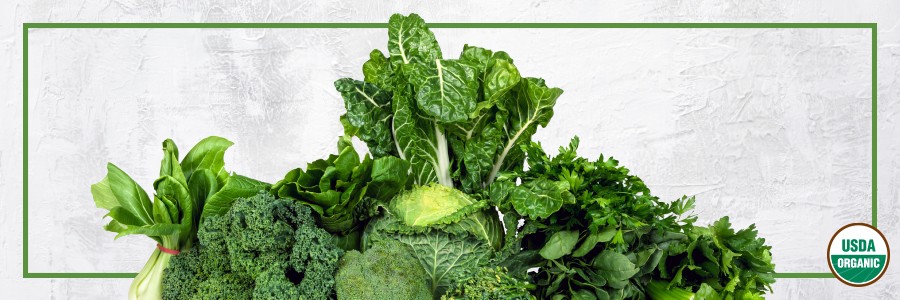


Sign-up for {N}power to get exclusive discounts, newsletters, members-only features, and more!

A forkful of leafy greens glistening with savory olive oil and vinegar dressing—it’s simply satisfying. With every crisp bite of fresh greens, you can feel your body begin to glow from the inside out. Greens, any which way you prepare them, are highly nutrient dense nourishment for your body. Whether it be spinach, kale, collards, or mustard greens, raw, sautéed, or braised, they’re sure to leave you feeling nourished and energized.

“Eat your greens!” Greens have a well-earned reputation as nutritional powerhouses. Here are just some of the wonderful benefits they provide:
Popeye was onto something—spinach contains protein, iron, and folate, nutrients your body needs to stay in tip-top shape. Fuel your workout with a cup of spinach in a smoothie or a salad—spinach is a high-quality source of protein containing all the essential amino acids.1 Iron is an essential element in blood—about 70 percent of the body’s iron is stored in hemoglobin, which is essential for transporting oxygen from the lungs to the tissues.2 And folate is required for protein metabolism, helps form healthy blood cells, supports cell growth and repair, and is necessary to form DNA and RNA.3 4
Vitamins A and C help fight free radicals and support clear and glowing skin from the inside out. One cup of kale contains 206 percent of the recommended daily intake of vitamin A and 134 percent of the recommended daily intake of vitamin C.5
Leafy greens are a great source of eye health-supporting nutrients like vitamin K, lutein, and zeaxanthin.6 Lutein is the most dominant carotenoid in brain tissue and vital to healthy eyesight, as it accumulates in the macula of the eye where it filters damaging blue light.7 8
Keep your gut happy with leafy greens like kale and collard greens that are rich in fiber and prebiotics. Fiber supports healthy digestion, and prebiotics feed your microbiome, supporting the immune system, strengthening the intestinal barrier, synthesizing essential vitamins, and supporting the body’s natural detoxification processes.9 10
 Though full of nutritious benefits, leafy greens are a notorious mainstay on the Environmental Working Group’s (EWG) Dirty Dozen list, and in 2022 spinach, collards, kale, and mustard greens took second and third place. Conventional leafy green farming relies heavily on synthetic pesticides: the EWG’s testing found as many as 21 different pesticides on a single sample, finding a total of 103 different pesticides used on these leafy greens.11 The most common pesticide found on conventional greens was dacthal, labeled by the EPA as a possible carcinogen and hormone disruptor.12 When it comes to all your leafy greens, choosing organic is especially important. In addition to keeping pesticides out of your green salads and smoothies, organic greens have also shown to be higher in antioxidants and polyphenols.13 14
Though full of nutritious benefits, leafy greens are a notorious mainstay on the Environmental Working Group’s (EWG) Dirty Dozen list, and in 2022 spinach, collards, kale, and mustard greens took second and third place. Conventional leafy green farming relies heavily on synthetic pesticides: the EWG’s testing found as many as 21 different pesticides on a single sample, finding a total of 103 different pesticides used on these leafy greens.11 The most common pesticide found on conventional greens was dacthal, labeled by the EPA as a possible carcinogen and hormone disruptor.12 When it comes to all your leafy greens, choosing organic is especially important. In addition to keeping pesticides out of your green salads and smoothies, organic greens have also shown to be higher in antioxidants and polyphenols.13 14
P.S., March 26th is National Spinach Day—celebrate with some delicious organic spinach!
 Try Our Easy Super-Greens Soup
Try Our Easy Super-Greens SoupThis soothing soup is healthy, comforting, and chock-full of superfoods. With garlic, ginger, turmeric, tomatoes, and a variety of greens, this soup is full of flavor and so easy to make.
GET THE RECIPE



Sign-up for {N}power to get exclusive discounts, newsletters, members-only features, and more!